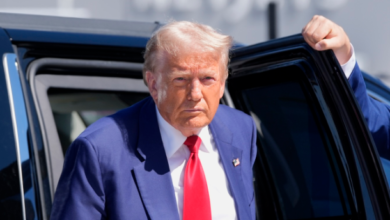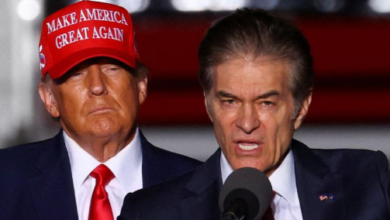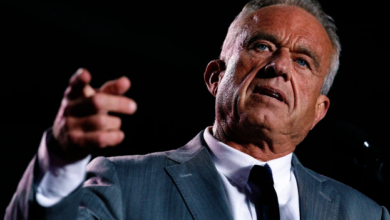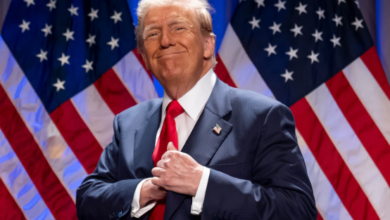Michael Bloomberg, Tom Steyer And The Case Of The Missing Megadonors


Former New York City Mayor Michael Bloomberg and venture capitalist Tom Steyer both spent substantial portions of their own multibillion-dolllar fortunes trying to win the presidency in 2020. Both men came up short in the Democratic primaries, though each had consolation prizes: Bloomberg managed to win American Samoa’s delegates and Steyer got to dance onstage to “Back That Ass Up” with Juvenile.
After their losses, however, each man also poured millions of dollars into efforts to defeat former President Donald Trump. Steyer gave tens of millions to NextGen America, a group he founded focused on increasing youth turnout. Bloomberg donated more than $100 million to various political action committees, including his gun safety-focused group Everytown.
This cycle, however, with Republicans nominating candidate after candidate who denies the results of the 2020 election and after the Supreme Court struck down Roe v. Wade, both men are giving substantially less to Democratic efforts, part of a wave of major Democratic donors who have cut back their giving, often arguing their efforts to defeat Trump two years ago were sufficient or feeling uncertain whether their money will be put to good use.
But in the case of Bloomberg and Steyer, there is a seemingly obvious and cynical reason their giving has slowed down.
“They were running for president in 2020. They were willing to put over $100 million in,” said one major Democratic donor, requesting anonymity because of Bloomberg’s and Steyer’s ongoing power in the party. “If they [aren’t] running, there [isn’t] anything to gain personally for them.”
While Senate Democratic candidates have used strong campaign fundraising to hold off GOP super PACs, House Democrats are getting walloped, with the executive director of the Democratic Congressional Campaign Committee telling HuffPost in an interview earlier this month the party needed large donors to step up. Moreover, both Steyer’s and Bloomberg’s past efforts have focused on subgroups — young voters and suburban swing voters — that could make or break Democratic chances in key seats.
In a phone interview, Bloomberg adviser Howard Wolfson noted the media mogul was still likely to be the single largest donor to Democratic Party efforts in 2022. Bloomberg will give $60 million, including $11 million to House Majority PAC, a super PAC controlled by allies of House Speaker Nancy Pelosi; $5 million or more to the League of Conservation Voters and EMILY’s List; and $1 million donations to different Democratic gubernatorial efforts. (The Washington Post first reported Bloomberg’s plans.)
The $60 million, however, is less than the $95 million he spent in 2018 or the $155 million he poured into defeating Trump in 2020, never mind the $1 billion he spent on his own presidential bid in 2020.
“Every election is important,” Wolfson said. “But the Trump-Biden election was pretty existential to the future of the country. This year’s elections are also really important, but if I had to rank them, I would say the 2020 election was more important.”
Interviews with Democratic operatives who work extensively with donors found the idea the midterm elections are less important than defeating Trump to be, in their eyes, frustratingly common.
“If you’re not giving now, what was the point of giving before?” asked one Democratic operative working extensively on House races, who requested anonymity to frankly discuss his frustration with some of the party’s biggest donors. “The threat is more real today than it’s ever been. A genuine problem we have in Democratic politics today is convincing some of our supporters that Republicans actually mean what they say.”
“January 6th was less than two years ago,” the operative said, referring to the 2021 insurrection at the U.S. Capitol.
Leah Greenberg, the co-executive director of the progressive group Indivisible, noted the midterms are going to set the table for the 2024 election — which could possibly be a Trump vs. Biden rematch.
“The outcomes of 2022 are going to determine the ground we’re fighting on in 2024, and whether we will even have free and fair elections. This is an election where election deniers are on the ballot from the Senate and gubernatorial levels all the way down to the local election administration offices,” Greenberg said. “We can’t afford to concede anything without fighting it out right now.”
In some ways, megadonors backing off is unsurprising: Midterm campaigns always cost less to run than presidential ones, and the amount of money poured into Democratic efforts in 2020 from both small and large donors was record-shattering, with the cash not always put to productive use.
“My guess is there are a lot of average people who will do less in 2022 than they did in 2020,” Wolfson said.
Many donors felt burned after giving to 2020 Senate campaigns, such as Jaime Harrison’s in South Carolina and Amy McGrath’s in Kentucky, that ended up losing badly. There is also a general pessimism about Democratic chances in the midterms. And finally, the stock market’s recent slump has some donors pinching their admittedly expansive wallets.
And ultimately, pointing fingers at donors for a poor Democratic performance in November would tell only a small slice of the story. Substantially lower gas prices or rates of inflation, or higher presidential approval ratings, would do far more for the party’s chances than any check.
Steyer, for his part, has donated a smaller amount to NextGen than he has in the past. Massive donations of $60 million for the 2018 cycle and nearly $50 million for the 2020 cycle funded thousands of organizers nationally, who rallied community colleges, small HBCUs, massive state universities and younger suburban moms to vote for Democrats. (In total, Steyer donated $73 million to all candidates and PACs in 2018 and $75 million in 2020.)
This year, NextGen has raised just $5.6 million as of its last Federal Election Commission report. Last week, it announced it was co-sponsoring a youth voter tour with the progressive group MoveOn.org, sending Sen. Bernie Sanders (I-Vt.) to the swing states of Michigan, Nevada, Pennsylvania and Wisconsin. The group has hired 140 field organizers across eight states, looking at 186 different college campuses. It’s also continued working with influencers and college athletes with substantial social media followings to encourage young people to register and vote.
In an email, a spokesperson for Steyer wrote that the venture capitalist is using a new firm — Galvanize Climate Solutions — to capitalize on the climate provisions of the Inflation Reduction Act and spur clean energy development.
“Tom believes this is the time for the private sector to lead in terms of climate response,” Niyati Narang wrote. “At Galvanize, he is fully focused on deploying critical climate solutions at scale and mobilizing private sector actors to invest in climate solutions.”
Narang noted Steyer’s $5 million donation to NextGen and wrote the “next phase of organizational growth for NextGen America will include building a broad base of support which will be key to the long-term sustainability of the organization.”
While Biden has unveiled two major policies with theoretical appeal for young people in recent months — student debt cancellation and moving toward the decriminalization of marijuana — the president has not mentioned them consistently while campaigning, and some progressives are increasingly worried about reaching young voters, the most liberal bloc of the American electorate.
“I am worried about the level of voter turnout among young people and working people who will be voting Democratic,” Sanders bluntly said on CNN’s “State of the Union” on Sunday.
Youth turnout could make or break this election cycle. Older voters always dominate midterm elections, but Democrats did far better in 2018 — when youth voters matched increased turnout for older voters — than they did in elections when younger people stayed home such as in 2014 and 2010.
A CBS News analysis earlier this month found if young people’s turnout matched 2018 levels, making them roughly a third of the electorate, control of the House would switch from leaning toward the GOP to a toss-up.
Bloomberg, on the other hand, has long focused his political operation on appealing to moderate voters in the suburbs, a group that overwhelmingly backed President Joe Biden in 2020 but has been lukewarm on Democratic House candidates in both 2020 and 2022.
It was a late cash blitz from Bloomberg that delivered suburban Democrats like Lucy McBath of Georgia and Kendra Horn of Oklahoma to Congress in 2018. And the $20 million he spent boosting Sen. Pat Toomey (R-Pa.) on gun control issues was considered critical to the Republican’s 2016 victory. (Bloomberg was still a registered independent when he backed Toomey.)
This time around, Everytown is airing ads on gun control, part of a Democratic counterpush on GOP ads on crime. But the amount spent is much lower. In Pennsylvania, for instance, Bloomberg has spent just over $1 million backing John Fetterman for the U.S. Senate.
Steyer and Bloomberg are not the only major donors who have pulled back. Donald Sussman, a hedge fund manager who has given millions to Democrats in the past, has not made substantial contributions this year in protest of Democrats’ failure to pass voting rights legislation.
Most aggravating to progressives, however, is the disappearance of a slew of big-money funders who backed moderate Democrats in House primaries around the country before disappearing in the lead-up to the general election. Pro-Israel groups spent more than $28 million attacking progressive Democrats, but most have done next to nothing as the party battles Republicans.
In particular, the crypto billionaire Sam Bankman-Fried has drawn the ire of progressives. Bankman-Fried, a proponent of effective altruism, has a number of pet issues including pandemic prevention and cryptocurrency regulation, and his giving during the primaries was not ideologically consistent. But he appears to have shut off the money spigot for the general election after spending $40 million earlier in the cycle and once speculating he could spend $1 billion.
“That was a dumb quote on my part,” the Bahamas-based 30-year-old told Politico Pro earlier this month. “I think my messaging was sort of sloppy and inconsistent in some cases.”
He added he saw less opportunity to advance his favored causes in a general election: “Frankly, I could try and talk about pandemic preparedness in a general election. But most voters are gonna say, ‘That’s cool, but like, I’m a Democrat’ or ‘I’m a Republican.’”
To Greenberg and others, however, the disappearance of Bankman-Fried and pro-Israel groups is evidence they are unreliable partners to the Democratic cause.
“I think it’s irresponsible to give people expectations that they think they can rely on, and then taking your ball and going home during a general election that’s going to be a huge fight for the future of the nation’s democracy,” Greenberg said.
At this point, however, there is little donors can do. Advertising rates are much lower when booked months in advance, so substantial donations won’t go as far at this point in the cycle. For example, one Democratic strategist told HuffPost a single spot on broadcast television in Las Vegas — which has contested gubernatorial and Senate races, plus three contested House races and numerous down-ballot contests — now costs $7,000.
“The best programs are ones you actually have time to develop and plan, and donors who wake up on Oct. 10 with six ideas don’t help matters,” said the strategist, who requested anonymity to criticize the people who sign his paychecks. “It’s more of a problem when there’s less dollars and you make up your mind late.”
Moreover, the simple fact that the decisions, whims and health of a few billionaires can have such seismic political impact points to the absurdity of the nation’s campaign finance laws, which have been gutted by a Supreme Court that equates money with speech and an FEC driven to paralysis by GOP obstruction.
“It’s not healthy for our system to be in a position where single donors can have such a big influence,” Greenberg said. “We are all facing a system where the unchecked power of dark money can shape the election.”
[ad_2]
Source link





